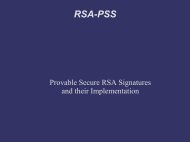RSA-PSS â Provably secure RSA Signatures and their ...
RSA-PSS â Provably secure RSA Signatures and their ...
RSA-PSS â Provably secure RSA Signatures and their ...
You also want an ePaper? Increase the reach of your titles
YUMPU automatically turns print PDFs into web optimized ePapers that Google loves.
MHashPadding1mHashsaltPadding2saltHashxorMGFbcmaskedDBHbcFigure 4: <strong>RSA</strong>SSA-<strong>PSS</strong> according to PKCS #1 v2.1 / RFC 3447 errata 8The variant that later became part of st<strong>and</strong>ards is slightly different. H <strong>and</strong>maskedDB are switched in <strong>their</strong> order. The input message M is hashed atthe beginning <strong>and</strong> then hashed again with a salt appended (see figure 4 for agraphical representation). We will discuss the security impact of those changeslater in chapter 5.It is in theory possible to set the salt size to zero. This makes <strong>PSS</strong> a deterministicalgorithm again which has security properties similar to Full DomainHashing.3.2 Appendix <strong>and</strong> Message Recovery<strong>PSS</strong> comes in two variants, with appendix <strong>and</strong> with message recovery. <strong>Signatures</strong>cheme with appendix (sometimes referred to as SSA) means that the signatureis an additional block of data appended to a signed message. Message recoverymeans that parts of the message are encoded within the signature. This can berelevant if the size of the transmitted data is a bottleneck <strong>and</strong> every byte matters– for example on smart cards. In the vast majority of applications, messagerecovery is not needed <strong>and</strong> signature scheme with appendix is the default <strong>and</strong>also the only variant of <strong>PSS</strong> specified in the PKCS #1 st<strong>and</strong>ard by <strong>RSA</strong> Inc.<strong>and</strong> the IETF (Internet Engineering Task Force).8 The diagram in the original version of PKCS #1 v2.1 / RFC 3447 is erroneous, however,the IETF never changes finished RFCs. The correct version of the diagram is listed in theRFC Errata at http://www.rfc-editor.org/errata_search.php?rfc=344713



